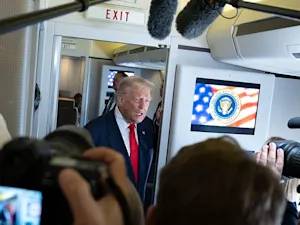
ICE Wants 30 Planes to Deport 30,000 Monthly
Imagine a fleet of sleek, government-owned jets soaring through the skies, not ferrying vacationers or business travelers, but deporting tens of thousands of immigrants every month. This is not a dystopian novel or a political thriller. It is the startling reality that Homeland Security Secretary Kristi Noem is reportedly pushing for — a billion-dollar plan to create the first-ever Immigration and Customs Enforcement airline. The goal? To turbocharge President Donald Trump's ambitious target of deporting 1 million undocumented immigrants annually.
A Billion-Dollar Deportation Machine
According to multiple sources, including NBC News and Forbes, Noem is championing the acquisition of around 30 commercial aircraft for ICE to own and operate directly. This would mark a dramatic shift from the agency's current practice of chartering planes from private companies. The estimated cost for this fleet ranges from a reported $2.4 billion to a staggering $12 billion, with individual planes priced between $80 million and $400 million each, based on aviation experts' estimates, according to NBC News.
The rationale behind this move is straightforward: owning a dedicated fleet would allow ICE to double its monthly deportation flights from roughly 15,000 to 30,000 or more. Jason Houser, ICE's former chief of staff, explained to NBC News that to meet the deportation goals set by the Trump administration, the agency would need to operate about 30 planes simultaneously.
From Charter to Control
Currently, ICE relies on charter companies to provide planes for deportation flights. These companies typically lease 8 to 14 planes at a time, with each flight costing ICE between $100,000 and $200,000 total. This fee covers the aircraft, pilots, flight attendants, security personnel, and medical staff. Charter companies also maintain the planes and ensure compliance with Federal Aviation Administration (FAA) regulations. When not in use by ICE, these planes are leased to other clients, including sports teams and political campaigns.
Owning its own fleet would mean ICE takes on the full responsibility of staffing, maintaining, and regulating the aircraft. The operational costs and logistical challenges of running an airline are significant, raising questions about the feasibility and efficiency of such a venture.
Funding the Flight Plan
The financial backing for this ambitious plan comes from President Trump's so-called "Big Beautiful Bill," a massive spending package that allocated over $75 billion to ICE over four years. This funding dwarfs the agency's previous annual budget of $9.5 billion and includes $30 billion specifically earmarked for removal operations, transportation, and detention center expansions, according to NBC News.
With this influx of cash, Noem appears poised to transform ICE's deportation capabilities dramatically. The agency has already chartered over 1,000 flights this year, with each flight reportedly costing approximately $25,000 per hour.
Owning planes could potentially reduce reliance on third-party contractors, but it also introduces new layers of complexity and expense.
The Political and Practical Stakes
The optics of a government-owned deportation airline are striking. Critics argue that the plan evokes images of an authoritarian state, where mass deportations are conducted with military-like precision and scale. The idea of a dedicated ICE airline conjures a dystopian vision of deportation jets crisscrossing the country, a symbol of political theater and budgetary excess.
Supporters, however, frame the initiative as a necessary step to meet the administration's immigration enforcement goals and to alleviate overcrowding in detention centers. With ICE rapidly increasing the number of detainees, more deportations are seen as essential to managing the system's capacity.
The Cost of Control
While owning a fleet might offer ICE greater control over deportation logistics, the financial and operational burdens are immense. Beyond the initial purchase price, the agency would need to cover ongoing maintenance, fuel, staffing, and regulatory compliance. The question remains whether these costs would ultimately save money compared to chartering flights or simply add another layer of bureaucracy.
According to NBC News, Jason Houser said that during his tenure under the Biden administration, ICE considered owning planes but lacked the necessary funding. The current budget surge under Trump's administration changes that calculus but does not eliminate the challenges.
Airlines and Public Backlash
ICE's reliance on private airlines has not been without controversy. Some carriers have faced public backlash and protests for their involvement in deportation flights. For example, Avelo Airlines, a low-cost carrier based in Houston, faced boycotts and criticism for chartering flights for ICE, leading to the shuttering of its west coast operations. The company's CEO, Andrew Levy, released a statement explaining, "There is rarely one singular reason why decisions like this are made, and this one is no different," as reported by the Independent. He continued, "We believe the continuation of service from [Burbank] in the current operating environment will not deliver adequate financial returns in a highly competitive backdrop."
What This Means for the Future
As the Trump administration pushes to fulfill its promise of the largest deportation campaign in American history, the creation of a government-operated ICE airline represents a bold and controversial escalation. The plan to spend billions on a deportation airline raises profound questions about the balance between enforcement, fiscal responsibility, and human dignity.
Deportation figures vary by source. NBC News and CBS report that ICE deported between 100,000 and 150,000 people in the first six months of Trump's current term, with projections of 300,000 by year-end, as reported by Forbes. The Independent cites at least 180,000 deportations as of August, while internal data varies. The 1 million deportation target remains a stated goal of the administration, not yet achieved.
For you, the reader, the image of billion-dollar deportation jets might provoke a mix of disbelief, concern, or even outrage. Whether you view this as a necessary enforcement tool or a disturbing overreach, the reality is that ICE is considering options to take its deportation efforts to new heights — literally.
The coming months will reveal whether this deportation airline becomes a reality or remains a costly political ambition. Either way, the plan signals a new chapter in America's ongoing debate over immigration, enforcement, and the limits of government power.
References: Kristi Noem is pushing for ICE to buy and operate a fleet of deportation planes, sources say | ICE Barbie Kristi Noem Wants Masked Goons to Run First-Ever 'ICE Air' | Kristi Noem Reportedly Wants First-Ever ICE Deportation Plane Fleet | Taking ICE to the skies: Noem wants a whole fleet of DHS owned planes to fly deportees back to their home countries | Budget airline that took ICE deportation flight contract shuts down West Coast operations






















